
Illustrative Math Alignment: Grade 6 Unit 8
Data Sets and Distributions
Lesson 1: Got Data?
Use the following Media4Math resources with this Illustrative Math lesson.
| Thumbnail Image | Title | Body | Curriculum Nodes |
|---|---|---|---|
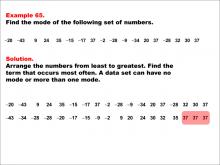
|
Math Example--Measures of Central Tendency--Mode: Example 65 | Math Example--Measures of Central Tendency--Mode: Example 65TopicMeasures of Central Tendency DescriptionThis example showcases a situation of measures of central tendency, where the goal is to identify a key summary measure in a set of data. Example 65 shows a list of numbers with the mode highlighted. The numbers are arranged in ascending order. This demonstrates how to identify the mode when a number appears more frequently than others in a data set that includes both positive and negative numbers. |
Data Analysis |
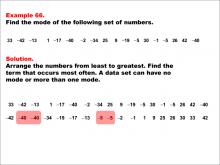
|
Math Example--Measures of Central Tendency--Mode: Example 66 | Math Example--Measures of Central Tendency--Mode: Example 66TopicMeasures of Central Tendency DescriptionThis example showcases a situation of measures of central tendency, where the goal is to identify a key summary measure in a set of data. Example 66 displays a set of numbers with two modes highlighted. The numbers are sorted in ascending order. This demonstrates that a data set can have multiple modes, even when it contains both positive and negative numbers. |
Data Analysis |
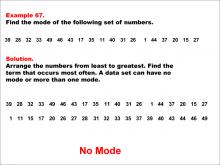
|
Math Example--Measures of Central Tendency--Mode: Example 67 | Math Example--Measures of Central Tendency--Mode: Example 67TopicMeasures of Central Tendency DescriptionThis example showcases a situation of measures of central tendency, where the goal is to identify a key summary measure in a set of data. Example 67 presents a list of numbers with no mode indicated. The numbers are sorted in ascending order. This example reinforces the concept that not all data sets have a mode, particularly when each number in the set appears only once. |
Data Analysis |
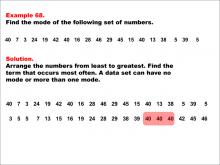
|
Math Example--Measures of Central Tendency--Mode: Example 68 | Math Example--Measures of Central Tendency--Mode: Example 68TopicMeasures of Central Tendency DescriptionThis example showcases a situation of measures of central tendency, where the goal is to identify a key summary measure in a set of data. Example 68 illustrates a set of numbers with the mode highlighted. The numbers are arranged in ascending order. This demonstrates how to identify the mode when a number appears more frequently than others in a data set. |
Data Analysis |
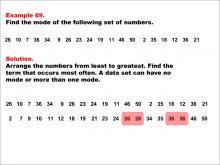
|
Math Example--Measures of Central Tendency--Mode: Example 69 | Math Example--Measures of Central Tendency--Mode: Example 69TopicMeasures of Central Tendency DescriptionThis example showcases a situation where there are multiple modes in a dataset. The image shows how numbers are arranged from least to greatest and highlights two modes: "26" and "36." This demonstrates that datasets can have more than one mode when two or more numbers appear with equal highest frequency. Lessons on measures of central tendency help students understand how to interpret data using different statistical measures like mean and median along with mode. |
Data Analysis |
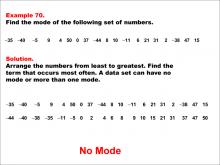
|
Math Example--Measures of Central Tendency--Mode: Example 70 | Math Example--Measures of Central Tendency--Mode: Example 70TopicMeasures of Central Tendency |
Data Analysis |

|
Math Example--Measures of Central Tendency--Mode: Example 71 | Math Example--Measures of Central Tendency--Mode: Example 71TopicMeasures of Central Tendency DescriptionThe image presents a math example on determining the mode of a sequence of numbers. After sorting them in order from least to greatest, the number -7 is highlighted as it appears most frequently. This demonstrates how to identify the mode when a number appears more frequently than others in a data set that includes both positive and negative numbers. Lessons on measures of central tendency help students understand how to interpret data using different statistical measures like mean and median along with mode. |
Data Analysis |
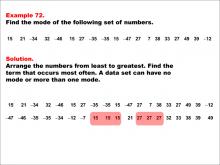
|
Math Example--Measures of Central Tendency--Mode: Example 72 | Math Example--Measures of Central Tendency--Mode: Example 72TopicMeasures of Central Tendency DescriptionThis image shows a math example on finding the mode in a data set. The numbers are sorted from least to greatest with two modes highlighted: 15 and 27. This demonstrates that a data set can have multiple modes, which occurs when two or more numbers appear with the highest frequency. Lessons on measures of central tendency help students understand how to interpret data using different statistical measures like mean and median along with mode. |
Data Analysis |
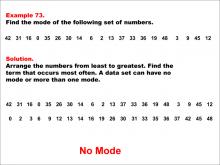
|
Math Example--Measures of Central Tendency--Mode: Example 73 | Math Example--Measures of Central Tendency--Mode: Example 73TopicMeasures of Central Tendency DescriptionThe image shows a math problem about finding the mode of a set of numbers. It includes the original set of numbers and the same set arranged in ascending order. The solution indicates "No Mode". This example reinforces the concept that not all data sets have a mode, particularly when each number in the set appears only once. Lessons on measures of central tendency help students understand how to interpret data using different statistical measures like mean and median along with mode. |
Data Analysis |
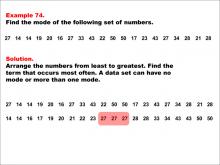
|
Math Example--Measures of Central Tendency--Mode: Example 74 | Math Example--Measures of Central Tendency--Mode: Example 74TopicMeasures of Central Tendency DescriptionThe image presents a math problem about finding the mode of a set of numbers. It shows the original set and the same set arranged in ascending order. The solution highlights the number 27 as occurring most frequently. This demonstrates how to identify the mode when a number appears more frequently than others in a data set. Lessons on measures of central tendency help students understand how to interpret data using different statistical measures like mean and median along with mode. |
Data Analysis |
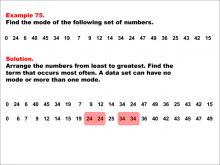
|
Math Example--Measures of Central Tendency--Mode: Example 75 | Math Example--Measures of Central Tendency--Mode: Example 75TopicMeasures of Central Tendency DescriptionThe image displays a math problem about finding the mode of a set of numbers. It includes the original set and the same set arranged in ascending order. The solution highlights two numbers, 24 and 34, as occurring most frequently. This demonstrates that a data set can have multiple modes, which occurs when two or more numbers appear with the highest frequency. Lessons on measures of central tendency help students understand how to interpret data using different statistical measures like mean and median along with mode. |
Data Analysis |

|
Math Example--Measures of Central Tendency--Mode: Example 76 | Math Example--Measures of Central Tendency--Mode: Example 76TopicMeasures of Central Tendency DescriptionThe image shows a math problem about finding the mode of a set of numbers. It presents the original set and the same set arranged in ascending order. The solution indicates "No Mode". This example reinforces the concept that not all data sets have a mode, particularly when each number in the set appears only once. Lessons on measures of central tendency help students understand how to interpret data using different statistical measures like mean and median along with mode. |
Data Analysis |
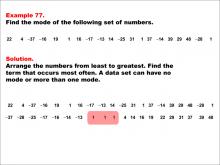
|
Math Example--Measures of Central Tendency--Mode: Example 77 | Math Example--Measures of Central Tendency--Mode: Example 77TopicMeasures of Central Tendency DescriptionThe image shows a math example focused on finding the mode of a set of numbers. The numbers are initially listed in random order and then rearranged from least to greatest. The mode is highlighted. This demonstrates how to identify the mode when a number appears more frequently than others in a data set that includes both positive and negative numbers. Lessons on measures of central tendency help students understand how to interpret data using different statistical measures like mean and median along with mode. |
Data Analysis |
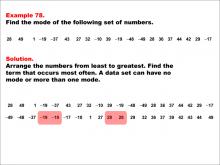
|
Math Example--Measures of Central Tendency--Mode: Example 78 | Math Example--Measures of Central Tendency--Mode: Example 78TopicMeasures of Central Tendency DescriptionThe image depicts another math example on finding the mode. It includes a list of numbers that are sorted from least to greatest. The mode is identified and highlighted in red. This demonstrates how to identify multiple modes when two or more numbers appear with equal highest frequency in a data set. Lessons on measures of central tendency help students understand how to interpret data using different statistical measures like mean and median along with mode. |
Data Analysis |
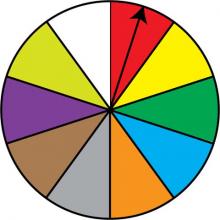
|
Math Clip Art: Spinner, 10 Sections--Result 1 | Math Clip Art: Spinner, 10 Sections--Result 1TopicProbability and Statistics DescriptionThis image depicts a spinner divided into ten equal sections, which are colored red, yellow, green, light blue, orange, grey, brown, purple, yellow-green, and white. The spinner's arrow points to the red section, demonstrating one of the possible outcomes. In the context of Probability and Statistics, this spinner represents a probability experiment with ten equally likely outcomes. It visually demonstrates the concepts of sample space and individual events within that space, each with a 1/10 probability of occurrence. |
Probability |
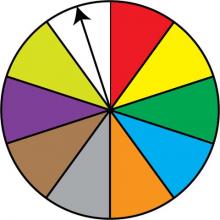
|
Math Clip Art: Spinner, 10 Sections--Result 10 | Math Clip Art: Spinner, 10 Sections--Result 10TopicProbability and Statistics DescriptionThis image depicts a spinner divided into ten equal sections, which are colored red, yellow, green, light blue, orange, grey, brown, purple, yellow-green, and white. The spinner's arrow points to the white section, demonstrating the final possible outcome in this probability model. In the field of Probability and Statistics, this spinner exemplifies a uniform probability distribution with ten equally likely outcomes. Each spin has a 1/10 probability of landing on any given color, illustrating the concept of equiprobable events in a complex scenario. |
Probability |
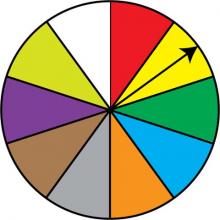
|
Math Clip Art: Spinner, 10 Sections--Result 2 | Math Clip Art: Spinner, 10 Sections--Result 2TopicProbability and Statistics DescriptionThis image depicts a spinner divided into ten equal sections, which are colored red, yellow, green, light blue, orange, grey, brown, purple, yellow-green, and white. The spinner's arrow points to the yellow section, demonstrating one of the possible outcomes. In the context of Probability and Statistics, this spinner represents a probability experiment with ten equally likely outcomes. It visually demonstrates the concepts of sample space and individual events within that space, each with a 1/10 probability of occurrence. |
Probability |
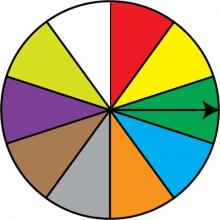
|
Math Clip Art: Spinner, 10 Sections--Result 3 | Math Clip Art: Spinner, 10 Sections--Result 3TopicProbability and Statistics DescriptionThis image depicts a spinner divided into ten equal sections, which are colored red, yellow, green, light blue, orange, grey, brown, purple, yellow-green, and white. The spinner's arrow points to the green section, demonstrating one of the possible outcomes. In the context of Probability and Statistics, this spinner represents a probability experiment with ten equally likely outcomes. It visually demonstrates the concepts of sample space and individual events within that space, each with a 1/10 probability of occurrence. |
Probability |
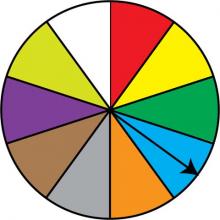
|
Math Clip Art: Spinner, 10 Sections--Result 4 | Math Clip Art: Spinner, 10 Sections--Result 4TopicProbability and Statistics DescriptionThis image depicts a spinner divided into ten equal sections, which are colored red, yellow, green, light blue, orange, grey, brown, purple, yellow-green, and white. The spinner's arrow points to the light blue section, demonstrating one of the possible outcomes. In the context of Probability and Statistics, this spinner represents a probability experiment with ten equally likely outcomes. It visually demonstrates the concepts of sample space and individual events within that space, each with a 1/10 probability of occurrence. |
Probability |

|
Math Clip Art: Spinner, 10 Sections--Result 5 | Math Clip Art: Spinner, 10 Sections--Result 5TopicProbability and Statistics DescriptionThis image depicts a spinner divided into ten equal sections, which are colored red, yellow, green, light blue, orange, grey, brown, purple, yellow-green, and white. The spinner's arrow points to the orange section, demonstrating one of the possible outcomes. In the context of Probability and Statistics, this spinner represents a probability experiment with ten equally likely outcomes. It visually demonstrates the concepts of sample space and individual events within that space, each with a 1/10 probability of occurrence. |
Probability |
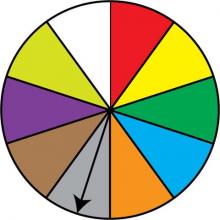
|
Math Clip Art: Spinner, 10 Sections--Result 6 | Math Clip Art: Spinner, 10 Sections--Result 6TopicProbability and Statistics DescriptionThis image depicts a spinner divided into ten equal sections, which are colored red, yellow, green, light blue, orange, grey, brown, purple, yellow-green, and white. The spinner's arrow points to the grey section, demonstrating one of the possible outcomes. In the context of Probability and Statistics, this spinner represents a probability experiment with ten equally likely outcomes. It visually demonstrates the concepts of sample space and individual events within that space, each with a 1/10 probability of occurrence. |
Probability |

|
Math Clip Art: Spinner, 10 Sections--Result 7 | Math Clip Art: Spinner, 10 Sections--Result 7TopicProbability and Statistics DescriptionThis image depicts a spinner divided into ten equal sections, which are colored red, yellow, green, light blue, orange, grey, brown, purple, yellow-green, and white. The spinner's arrow points to the brown section, demonstrating one of the possible outcomes. In the context of Probability and Statistics, this spinner represents a probability experiment with ten equally likely outcomes. It visually demonstrates the concepts of sample space and individual events within that space, each with a 1/10 probability of occurrence. |
Probability |
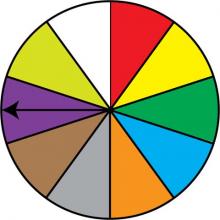
|
Math Clip Art: Spinner, 10 Sections--Result 8 | Math Clip Art: Spinner, 10 Sections--Result 8TopicProbability and Statistics DescriptionThis image depicts a spinner divided into ten equal sections, which are colored red, yellow, green, light blue, orange, grey, brown, purple, yellow-green, and white. The spinner's arrow points to the purple section, demonstrating one of the possible outcomes. In the context of Probability and Statistics, this spinner represents a probability experiment with ten equally likely outcomes. It visually demonstrates the concepts of sample space and individual events within that space, each with a 1/10 probability of occurrence. |
Probability |
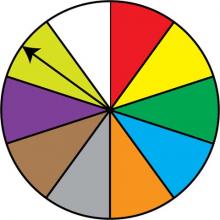
|
Math Clip Art: Spinner, 10 Sections--Result 9 | Math Clip Art: Spinner, 10 Sections--Result 9TopicProbability and Statistics DescriptionThis image depicts a spinner divided into ten equal sections, which are colored red, yellow, green, light blue, orange, grey, brown, purple, yellow-green, and white. The spinner's arrow points to the yellow-green section, demonstrating one of the possible outcomes. In the context of Probability and Statistics, this spinner represents a probability experiment with ten equally likely outcomes. It visually demonstrates the concepts of sample space and individual events within that space, each with a 1/10 probability of occurrence. |
Probability |

|
Math Clip Art: Spinner, 2 Sections--Result 1 | Math Clip Art: Spinner, 2 Sections--Result 1TopicProbability and Statistics DescriptionThis image depicts a basic spinner divided into two equal sections, colored red and yellow. The spinner's arrow points to the yellow section, indicating a specific result. This spinner relates to Probability and Statistics by visually representing a simple probability model. With two equal sections, each outcome has a 50% chance of occurring, demonstrating the concept of equally likely events. |
Probability |
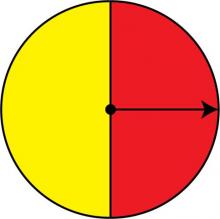
|
Math Clip Art: Spinner, 2 Sections--Result 2 | Math Clip Art: Spinner, 2 Sections--Result 2TopicProbability and Statistics DescriptionThis image shows a spinner divided into two equal sections, colored red and yellow. The spinner's arrow points to the red section, illustrating a different outcome from the previous image. In the context of Probability and Statistics, this spinner represents a simple probability experiment with two equally likely outcomes. It visually demonstrates the concept of sample space and individual events within that space. |
Probability |
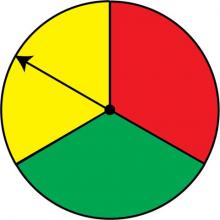
|
Math Clip Art: Spinner, 3 Sections--Result 1 | Math Clip Art: Spinner, 3 Sections--Result 1TopicProbability and Statistics DescriptionThis image presents a spinner divided into three equal sections colored red, green, and yellow. The spinner's arrow points to the yellow section, illustrating one possible outcome. In the realm of Probability and Statistics, this spinner introduces a more complex probability model compared to simpler two-section designs. It exemplifies the concept of equally likely events in a scenario with three possible outcomes, each with a probability of 1/3. |
Probability |
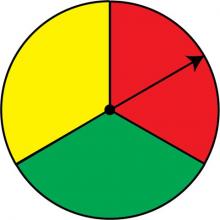
|
Math Clip Art: Spinner, 3 Sections--Result 2 | Math Clip Art: Spinner, 3 Sections--Result 2TopicProbability and Statistics DescriptionThis image showcases a spinner divided into three equal sections colored red, green, and yellow. The spinner's arrow points to the red section, demonstrating another possible outcome. In the context of Probability and Statistics, this spinner represents a probability experiment with three equally likely outcomes. It visually demonstrates the concepts of sample space and individual events within that space, each with a 1/3 probability of occurrence. |
Probability |

|
Math Clip Art: Spinner, 3 Sections--Result 3 | Math Clip Art: Spinner, 3 Sections--Result 3TopicProbability and Statistics DescriptionThis image depicts a spinner divided into three equal sections colored red, green, and yellow. The spinner's arrow points to the green section, showcasing the third possible outcome in this probability model. In Probability and Statistics, this spinner illustrates a fair probability experiment with three mutually exclusive and equally likely outcomes. It provides a visual representation of how each spin has an equal 1/3 chance of landing on any of the three colors. |
Probability |
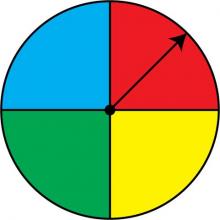
|
Math Clip Art: Spinner, 4 Sections--Result 1 | Math Clip Art: Spinner, 4 Sections--Result 1TopicProbability and Statistics DescriptionThis image features a spinner divided into four equal segments: red, yellow, green, and blue. The spinner's arrow points to the red section, depicting a sample outcome in this probability model. This spinner model is part of Probability and Statistics, as it visually exemplifies an experimental probability experiment with four equally likely sections, each representing a probability of 1/4. Teachers can use such images to facilitate discussions on probability, permutations, and likelihood, allowing students to explore and compare theoretical predictions with practical results. |
Probability |
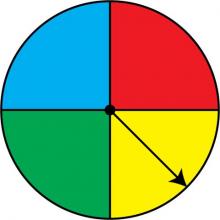
|
Math Clip Art: Spinner, 4 Sections--Result 2 | Math Clip Art: Spinner, 4 Sections--Result 2TopicProbability and Statistics DescriptionThis image showcases a spinner divided into four equal segments: red, yellow, green, and blue. The spinner's arrow points to the yellow section, illustrating another possible outcome in this probability model. As part of Probability and Statistics, this spinner visually represents an experimental probability scenario with four equally likely outcomes, each with a 1/4 probability of occurring. |
Probability |
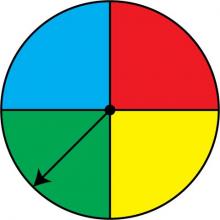
|
Math Clip Art: Spinner, 4 Sections--Result 3 | Math Clip Art: Spinner, 4 Sections--Result 3TopicProbability and Statistics DescriptionThis image depicts a spinner divided into four equal segments: red, yellow, green, and blue. The spinner's arrow points to the green section, showcasing another possible outcome in this probability model. In the context of Probability and Statistics, this spinner illustrates a fair probability experiment with four mutually exclusive and equally likely outcomes. It provides a visual representation of how each spin has an equal 1/4 chance of landing on any of the four colors. |
Probability |
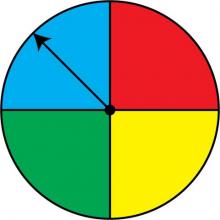
|
Math Clip Art: Spinner, 4 Sections--Result 4 | Math Clip Art: Spinner, 4 Sections--Result 4TopicProbability and Statistics DescriptionThis image presents a spinner divided into four equal segments: red, yellow, green, and blue. The spinner's arrow points to the blue section, completing the set of possible outcomes in this probability model. In the field of Probability and Statistics, this spinner exemplifies a uniform probability distribution with four equally likely outcomes. Each spin has a 1/4 probability of landing on any given color, illustrating the concept of equiprobable events. |
Probability |
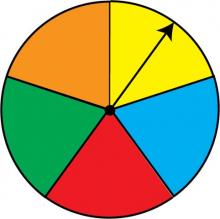
|
Math Clip Art: Spinner, 5 Sections--Result 1 | Math Clip Art: Spinner, 5 Sections--Result 1TopicProbability and Statistics DescriptionThis image displays a spinner divided into five equal sections: yellow, blue, red, green, and orange. The spinner's arrow currently points to the yellow section, indicating one of the five possible outcomes. In Probability and Statistics, this spinner serves as a vivid example of an experiment with multiple equally likely outcomes. Each section of the spinner represents a 1/5 probability, making it a useful tool for teaching the concept of equally probable events. |
Probability |

|
Math Clip Art: Spinner, 5 Sections--Result 2 | Math Clip Art: Spinner, 5 Sections--Result 2TopicProbability and Statistics DescriptionThis image presents a spinner divided into five equal sections: yellow, blue, red, green, and orange. The spinner's arrow is pointing to the orange section, demonstrating another possible outcome of this probability model. In the realm of Probability and Statistics, this spinner exemplifies a uniform probability distribution with five equally likely outcomes. Each spin has a 1/5 probability of landing on any given color, illustrating the concept of equiprobable events. |
Probability |
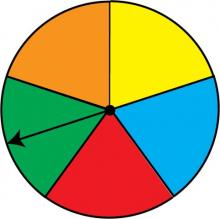
|
Math Clip Art: Spinner, 5 Sections--Result 3 | Math Clip Art: Spinner, 5 Sections--Result 3TopicProbability and Statistics DescriptionThis image showcases a spinner divided into five equal sections colored yellow, blue, red, green, and orange. The spinner's arrow points to the green section, demonstrating another possible outcome in this probability model. In the context of Probability and Statistics, this spinner represents a probability experiment with five equally likely outcomes. It visually demonstrates the concepts of sample space and individual events within that space, each with a 1/5 probability of occurrence. |
Probability |

|
Math Clip Art: Spinner, 5 Sections--Result 4 | Math Clip Art: Spinner, 5 Sections--Result 4TopicProbability and Statistics DescriptionThis image depicts a spinner divided into five equal sections colored yellow, blue, red, green, and orange. The spinner's arrow points to the red section, showcasing the fourth possible outcome in this probability model. In Probability and Statistics, this spinner illustrates a fair probability experiment with five mutually exclusive and equally likely outcomes. It provides a visual representation of how each spin has an equal 1/5 chance of landing on any of the five colors. |
Probability |
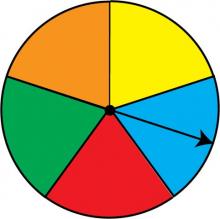
|
Math Clip Art: Spinner, 5 Sections--Result 5 | Math Clip Art: Spinner, 5 Sections--Result 5TopicProbability and Statistics DescriptionThis image presents a spinner divided into five equal sections: yellow, blue, red, green, and orange. The spinner's arrow points to the blue section, completing the set of possible outcomes in this probability model. In the field of Probability and Statistics, this spinner exemplifies a uniform probability distribution with five equally likely outcomes. Each spin has a 1/5 probability of landing on any given color, illustrating the concept of equiprobable events. |
Probability |

|
Math Clip Art: Spinner, 6 Sections--Result 1 | Math Clip Art: Spinner, 6 Sections--Result 1TopicProbability and Statistics DescriptionThis image displays a spinner divided into six equal sections: yellow, blue, orange, grey, red, and green. The spinner's arrow currently points to the red section, indicating one of the six possible outcomes. In Probability and Statistics, this spinner serves as a vivid example of an experiment with multiple equally likely outcomes. Each section of the spinner represents a 1/6 probability, making it a useful tool for teaching the concept of equally probable events. |
Probability |
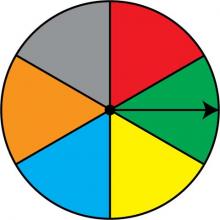
|
Math Clip Art: Spinner, 6 Sections--Result 2 | Math Clip Art: Spinner, 6 Sections--Result 2TopicProbability and Statistics DescriptionThis image displays a spinner divided into six equal sections: yellow, blue, orange, grey, red, and green. The spinner's arrow currently points to the green section, indicating one of the six possible outcomes. In Probability and Statistics, this spinner serves as a vivid example of an experiment with multiple equally likely outcomes. Each section of the spinner represents a 1/6 probability, making it a useful tool for teaching the concept of equally probable events. |
Probability |
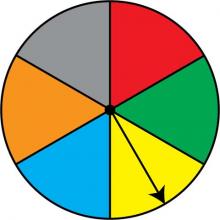
|
Math Clip Art: Spinner, 6 Sections--Result 3 | Math Clip Art: Spinner, 6 Sections--Result 3TopicProbability and Statistics DescriptionThis image displays a spinner divided into six equal sections: yellow, blue, orange, grey, red, and green. The spinner's arrow currently points to the yellow section, indicating one of the six possible outcomes. In Probability and Statistics, this spinner serves as a vivid example of an experiment with multiple equally likely outcomes. Each section of the spinner represents a 1/6 probability, making it a useful tool for teaching the concept of equally probable events. |
Probability |
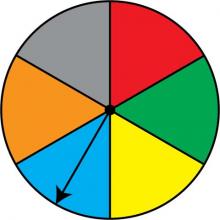
|
Math Clip Art: Spinner, 6 Sections--Result 4 | Math Clip Art: Spinner, 6 Sections--Result 4TopicProbability and Statistics DescriptionThis image displays a spinner divided into six equal sections: yellow, blue, orange, grey, red, and green. The spinner's arrow currently points to the blue section, indicating one of the six possible outcomes. In Probability and Statistics, this spinner serves as a vivid example of an experiment with multiple equally likely outcomes. Each section of the spinner represents a 1/6 probability, making it a useful tool for teaching the concept of equally probable events. |
Probability |

|
Math Clip Art: Spinner, 6 Sections--Result 5 | Math Clip Art: Spinner, 6 Sections--Result 5TopicProbability and Statistics DescriptionThis image displays a spinner divided into six equal sections: yellow, blue, orange, grey, red, and green. The spinner's arrow currently points to the orange section, indicating one of the six possible outcomes. In Probability and Statistics, this spinner serves as a vivid example of an experiment with multiple equally likely outcomes. Each section of the spinner represents a 1/6 probability, making it a useful tool for teaching the concept of equally probable events. |
Probability |
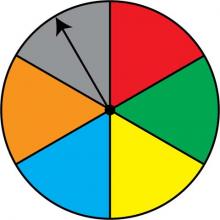
|
Math Clip Art: Spinner, 6 Sections--Result 6 | Math Clip Art: Spinner, 6 Sections--Result 6TopicProbability and Statistics DescriptionThis image displays a spinner divided into six equal sections: yellow, blue, orange, grey, red, and green. The spinner's arrow currently points to the grey section, indicating one of the six possible outcomes. In Probability and Statistics, this spinner serves as a vivid example of an experiment with multiple equally likely outcomes. Each section of the spinner represents a 1/6 probability, making it a useful tool for teaching the concept of equally probable events. |
Probability |
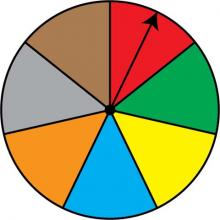
|
Math Clip Art: Spinner, 7 Sections--Result 1 | Math Clip Art: Spinner, 7 Sections--Result 1TopicProbability and Statistics DescriptionThis image showcases a spinner divided into seven equal sections colored red, green, yellow, blue, orange, grey, and brown. The spinner's arrow points to the red section, illustrating one of the seven possible outcomes. In the context of Probability and Statistics, this spinner represents a more complex probability model with seven equally likely outcomes. Each section has a probability of 1/7, demonstrating how probability changes as the number of possible outcomes increases. |
Probability |
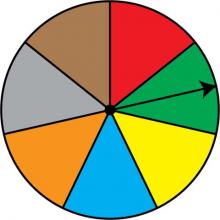
|
Math Clip Art: Spinner, 7 Sections--Result 2 | Math Clip Art: Spinner, 7 Sections--Result 2TopicProbability and Statistics DescriptionThis image presents a spinner divided into seven equal sections colored red, green, yellow, blue, orange, grey, and brown. The spinner's arrow points to the green section, showcasing another possible outcome in this probability model. In Probability and Statistics, this spinner illustrates a fair probability experiment with seven mutually exclusive and equally likely outcomes. It provides a visual representation of how each spin has an equal 1/7 chance of landing on any of the seven colors. |
Probability |
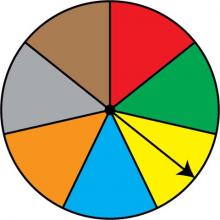
|
Math Clip Art: Spinner, 7 Sections--Result 3 | Math Clip Art: Spinner, 7 Sections--Result 3TopicProbability and Statistics DescriptionThis image displays a spinner divided into seven equal sections colored red, green, yellow, blue, orange, grey, and brown. The spinner's arrow points to the yellow section, demonstrating the third possible outcome in this probability model. In the field of Probability and Statistics, this spinner exemplifies a uniform probability distribution with seven equally likely outcomes. Each spin has a 1/7 probability of landing on any given color, illustrating the concept of equiprobable events in a more complex scenario. |
Probability |
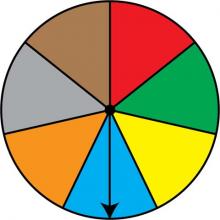
|
Math Clip Art: Spinner, 7 Sections--Result 4 | Math Clip Art: Spinner, 7 Sections--Result 4TopicProbability and Statistics DescriptionThis image features a spinner divided into seven equal segments colored red, green, yellow, blue, orange, grey, and brown. The spinner's arrow points to the blue section, depicting the fourth possible outcome in this probability model. In Probability and Statistics, this spinner serves as a vivid example of an experiment with multiple equally likely outcomes. Each section of the spinner represents a 1/7 probability, making it a useful tool for teaching the concept of equally probable events in more complex scenarios. |
Probability |
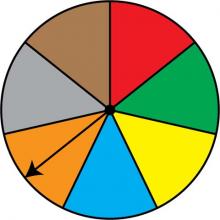
|
Math Clip Art: Spinner, 7 Sections--Result 5 | Math Clip Art: Spinner, 7 Sections--Result 5TopicProbability and Statistics DescriptionThis image presents a spinner divided into seven equal sections colored red, green, yellow, blue, orange, grey, and brown. The spinner's arrow points to the orange section, illustrating the fifth possible outcome in this probability model. In the realm of Probability and Statistics, this spinner exemplifies a uniform probability distribution with seven equally likely outcomes. Each spin has a 1/7 probability of landing on any given color, demonstrating how probability concepts apply in scenarios with multiple outcomes. |
Probability |

|
Math Clip Art: Spinner, 7 Sections--Result 6 | Math Clip Art: Spinner, 7 Sections--Result 6TopicProbability and Statistics DescriptionThis image showcases a spinner divided into seven equal sections colored red, green, yellow, blue, orange, grey, and brown. The spinner's arrow points to the grey section, demonstrating the sixth possible outcome in this probability model. In the context of Probability and Statistics, this spinner represents a more complex probability experiment with seven equally likely outcomes. It visually demonstrates the concepts of sample space and individual events within that space, each with a 1/7 probability of occurrence. |
Probability |